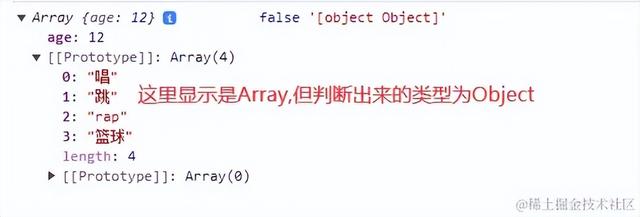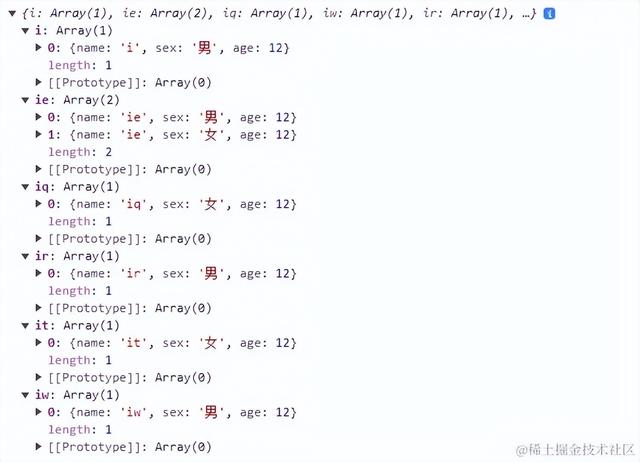前言

在js中,对象类型是非常重要的类型之一,也是项目中数据处理常用的类型之一,虽然这种类型我们经常使用,但是它的方法却不怎么用的到或者很少用到,不知不觉js的对象方法已经来到了29个了,今天就来看看这29个方法的使用。
还有当typeof Array的时候,会发现数组是一个对象类型,也可以说数组是一个特殊的对象,所以大多对象的方法都可以对数组使用,而且有些效果可能会使你大跌眼镜。
正文
Object.defineProperty 劫持对象属性
了解vue的应该都比较熟悉这个方法了,因为在vue2中,底层的响应拦截就是使用的Object.defineProperty加观察者模式实现的。首先说这个是因为描述对象在后面一些方法中都会使用到。
Object.defineProperty方法接收三个参数,第一个为目标对象,第二个是要添加或修改的属性,三个为描述对象,返回传入的对象。
描述对象的属性:
- configurable是否可配置的:默认为false,当为false的时候,该属性无法被配置。
- enumerable是否可枚举:默认false,当为false的时候,该属性无法被枚举,也是就是使用in操作符,或者for in 的时候无法被找到。
- writable是否可写:默认false,当为false的时候,该属性无法被修改。
- value属性值:默认undefined,可以是js中的任何类型任何值
- get方法:返回值默认undefined。当访问该属性的时候会调用此方法,访问时,所得到的属性值是该方法的返回值。
- set方法:默认值为undefined。当修改该属性时会调用此方法。
注意:当配置对象中存在value和writable属性时,不应该存在get和set方法,反之亦然。当value属性和get方法同时存在时,会报错。
const obj = { name: "iceCode" };//这里接不接收返回值都可以,因为返回也是传入的对象。//age属性值不存在obj对象里,这里就会新增。const newObj = Object.defineProperty(obj, "age", { value: "12", configurable: true, writable: true, enumerable: true,});console.log(newObj, obj, newObj === obj);//{ name: 'iceCode', age: '12' }//{ name: 'iceCode', age: '12' }//true如果非要在添加value的时候添加get和set方法则会报错。
const obj = { name: "iceCode" };//这里接不接收返回值都可以,因为返回也是传入的对象。//age属性值不存在obj对象里,这里就会新增。const newObj = Object.defineProperty(obj, "age", { value: "12", configurable: true, writable: true, enumerable: true, get() { return this.value; }, set(val) { this.value = val; },});
使用get和set来改变对象属性,有些情况可能我们在vue的项目中见到过,当打印当前数据的时候发现控制台中显示的数据并不是最新的,但是展开之后,反而却显示最新的数据了。
这是因为 JavaScript 中的对象是动态的,随时可能发生变化。当你使用 console.log 打印对象时,实际上是获取了这个对象在打印时的状态,而不是实时状态。而当你展开一个对象时,实际上是重新获取了这个对象的所有属性值,因此你看到的是最新的状态。
const obj = { name: "iceCode" };let value = 12;const newObj = Object.defineProperty(obj, "age", { enumerable: true, configurable: true, get() { return value; }, set(val) { value = val; },});//在这里打印的数据可能在vue的项目见过console.log(newObj, obj, newObj === obj);
对象说完了,但是当目标对象是一个数组的时候呢,结果又是如何的。
const arr: string[] = [];const newObj = Object.defineProperty(arr, "age", { value: "iceCode", writable: true, enumerable: true, configurable: true,});//返回值和目标对象是同一个,所以打印哪个都是一样的console.log(newObj);猜到结果了吗?见过这种类型没。

那么这种类型是数组还是对象,访问它里面的值得时候又该如何访问呢
//这里打印一下他们的结果console.log(newObj);console.log(Array.isArray(newObj));console.log(newObj[0]);console.log(newObj.age);
这时再看这个数组它能使用那种方法遍历呢?
//这里为了更清晰得看出结果,数组中添加了一个数据const arr: string[] = ["222"];const newObj = Object.defineProperty(arr, "age", { value: "iceCode", writable: true, enumerable: true,//这里确定是可枚举得 configurable: true,});//使用三种方法来遍历这个数组for (const value of newObj) { console.log(value, "for of");}newObj.forEach((item) => { console.log(item, "forEach");});for (const key in newObj) { console.log(key, newObj[key], "for in");}
使用Object.defineProperty往数组中添加一个对象可以得到一个令人大跌眼镜得效果,但这个添加得对象也属于是身在曹营心在汉了,即便是在数组中,但想要访问它或者遍历它必须要使用对象得方式才能得到它。
那如果对这个数组添加元素或者修改元素,又或者使用属性名修改元素又是怎么样的呢?
//看着有些奇怪的操纵newObj.push("123");newObj.name = "不存在的";newObj.age = 18;newObj[2] = "以存在的";console.log(newObj);最后的结果是相互不影响的,属性值可被更改,没有的属性可以被添加,使用push添加的元素已索引的形式单独存在。

Object.defineProperties 劫持对象
这个方法可以说是Object.defineProperty的强化版,相比较于Object.defineProperty每次只能劫持一个属性对其配置,这个方法可以一次性对多个属性进行劫持。
Object.defineProperties接收两个参数,第一个目标对象,第二个是一个对象,对象的每一个key就是要劫持属性值,对象的value是该属性值的配置对象。返回目标对象。
const obj = { name: "iceCode" };const newObj = Object.defineProperties(obj, {//对于已经有的属性,会修改当前值 name: { value: "icedCode", writable: true, enumerable: true, }, //对于没有的会新增 age: { value: 18, writable: true, enumerable: true, },});console.log(newObj);//{name: 'icedCode', age: 18}假如目标对象是一个数组的话和Object.defineProperty是一样的,获取修改和添加值也都是相同的操作。

Object.assign 对对象的浅拷贝
Object.assign接收两个参数或以上的参数,第一个参数是目标对象,第二个或多是被拷贝的对象,返回目标对象本身。 这里的浅拷贝是将被拷贝对象的属性赋值到目标对象上
const obj = { name: "iceCode" };const age = { age: 18 };const my= { interest: ["唱", "跳", "rap", "篮球"] }const newObj = Object.assign(obj, age, my);//这里返回值和目标对象是同一个对象console.log(newObj, newObj === obj);//{name: 'iceCode', age: 18, interest: ["唱", "跳", "rap", "篮球"]} true//这里修改obj的age属性是不会影响到原对象的age,但是修改interest里数组的内容是会改变原对象的属性值的obj.age = 24;obj.interest.push("足球");console.log(obj, age, my);//{name: 'iceCode', age: 24, interest: ["唱", "跳", "rap", "篮球","足球"]}//{age:18}//{interest: ['唱', '跳', 'rap', '篮球', '足球']}假如目标对象是一个数组... 对,还是身在曹营心在汉的场景,并且类型是Array

Object.create 以现有的对象作为原型创建一个新的对象
Object.create创建一个新的对象,接收两个参数,创建新对象的原型对象,第二个参数同Object.defineProperties第二个参数相同,里面的值作为创建新对象本身的属性和属性值
const obj = { name: "iceCode" };//obj作为原型对象,第二个参数作为新对象本身的参数const newObj = Object.create(obj, { age: { value: 12, writable: true, enumerable: true, configurable: true, },});console.log(newObj);
如果第一个参数是数组,那么这个新对象的原型就是数组
const obj = { name: "iceCode" };const interest = ["唱", "跳", "rap", "篮球"];const newObj = Object.create(interest, { age: { value: 12, writable: true, enumerable: true, },});//显示这个新对象,判断是否是数组,判断一下类型console.log(newObj, Array.isArray(newObj), Object.prototype.toString.call(newObj));
Object.freeze 冻结对象
Object.freeze方法冻结对象,使目标对象不可配置(使用Object.defineProperty等方法修改对象的操作权限),不可扩展,不可删除,不可修改(包括改变原型)。接收一个要被冻结的对象,返回这个对象。
注意:一旦这个对象被冻结,那么这个操作就不可逆,该对象无法被解冻
const obj = { name: "iceCode" };const newObj = Object.freeze(obj);//冻结之后,一下操作都是会报错的newObj.name = "我是队长阿威呀";delete newObj.name;newObj.age = 18;newObj.__proto__ = { age: 18 };//但是修改或添加原型的属性是可以的,原型引用没有改变newObj.__proto__.age = 18;Object.isFrozen 判断对象是否被冻结
Object.isFrozen判断一个对象是否被冻结,如果被冻结返回true,否则返回false。
- 一个空的不可扩展对象会认为是冻结对象
- 如果一个不可扩展的对象里有属性,且被删除了属性,会认为是冻结对象
- 如果一个不可扩展的对象里有属性,且被配置为不可配置并且不可写( configurable: false,writable: false,),会认为是冻结对象
- 如果一个不可扩展的对象里有一个访问器属性,且被配置为不可配置并且不可写( configurable: false,writable: false,),会认为是冻结对象
- 使用Object.freeze冻结一个对象会被认为是冻结对象
//不可扩展const newObj1 = Object.preventExtensions({});const newObj2 = Object.preventExtensions({ name: "iced" });delete newObj2.name;const newObj3 = Object.preventExtensions({ name: "iced" });Object.defineProperty(newObj3, "name", { configurable: false, writable: false,});const newObj4 = Object.preventExtensions({ get name() { return "iceCode"; },});Object.defineProperty(newObj4, "name", { configurable: false, writable: false,});const newObj = Object.freeze(obj);console.log(Object.isFrozen(newObj));//trueconsole.log(Object.isFrozen(newObj1));//trueconsole.log(Object.isFrozen(newObj2));//trueconsole.log(Object.isFrozen(newObj3));//trueconsole.log(Object.isFrozen(newObj4));//trueObject.seal 密封一个对象
Object.seal密封一个对象,与Object.freeze相比可以更改对象中现有的属性,一样不可删除,不可添加等操作
const obj = { name: "iceCode" };const newObj = Object.seal(obj);//等操作是会报错的 但可以修改delete newObj.name;newObj.age = 18;Object.isSealed 判断一个对象是否被密封
Object.isSealed判断一个对象是否被密封,如果被冻结返回true,否则返回false。判断基本如上,并且冻结的一定是密封的
- 一个空的不可扩展对象会认为是密封对象
- 如果一个不可扩展的对象里有属性,且被删除了属性,会认为是密封对象
- 如果一个不可扩展的对象里有属性,且被配置为不可配置( configurable: false),会认为是密封对象
- 如果一个不可扩展的对象里有一个访问器属性,且被配置为不可配置( configurable: false),会认为是密封对象
- 使用Object.seal密封一个对象会被认为是密封对象
- 使用Object.freeze冻结一个对象会被认为是密封对象
//不可扩展const newObj1 = Object.preventExtensions({});const newObj2 = Object.preventExtensions({ name: "iced" });delete newObj2.name;const newObj3 = Object.preventExtensions({ name: "iced" });Object.defineProperty(newObj3, "name", { configurable: false,});const newObj4 = Object.preventExtensions({ get name() { return "iceCode"; },});Object.defineProperty(newObj4, "name", { configurable: false,});const newObj5 = Object.seal(obj);const newObj = Object.freeze(obj);console.log(Object.isSealed(newObj));//trueconsole.log(Object.isSealed(newObj1));//trueconsole.log(Object.isSealed(newObj2));//trueconsole.log(Object.isSealed(newObj3));//trueconsole.log(Object.isSealed(newObj4));//trueconsole.log(Object.isSealed(newObj5));//trueObject.preventExtensions 禁止对象扩展
Object.preventExtensions禁止对象的扩展操作,除了不可以添加新的属性以外其他的都可以,原型一样不可以被重新指定
const obj = { name: "iceCode" };const newObj = Object.preventExtensions(obj);//修改删除操作都是可以的newObj.name = "iced";delete newObj.name;Object.isExtensible 判断一个对象是否可扩展
Object.isExtensible判断一个对象是否可扩展,返回要给布尔值。默认的普通对象是可扩展的所以为true,不可扩展的对象为false。
- 当对象被冻结时是不可扩展的
- 当对象被密封时是不可扩展的
- 当对象被标记为不可扩展时是不可扩展的
const obj = { name: "iceCode" };const newObj = Object.preventExtensions(obj);const newObj1 = Object.seal(obj);const newObj2 = Object.freeze(obj);console.log(Object.isExtensible({})); //trueconsole.log(Object.isExtensible(newObj)); //falseconsole.log(Object.isExtensible(newObj1)); //falseconsole.log(Object.isExtensible(newObj2)); //false另外:冻结、密封、不可扩展方法对数组都是可用的,同样无法添加新的属性或修改等一些操作,这里就不演示了
Object.fromEntries 将键值对列表转成对象
Object.fromEntries会将键值对格式的列表转化成对象,比如Map类型数据,或二维数组数据
const arr: any[] = [ ["2", "4"], ["name", "iceCdoe"], ["age", 18],];const map = new Map(arr);const newObj = Object.fromEntries(map);const newObj1 = Object.fromEntries(arr);console.log(newObj);//{2: '4', name: 'iceCdoe', age: 18}console.log(newObj1);//{2: '4', name: 'iceCdoe', age: 18}Object.prototype.hasOwnProperty 查找对象本身是否存在这个属性
Object.prototype.hasOwnProperty是一个原型方法,实例对象调用此方法会查找到自身是否存在这个属性,返回一个布尔值,如果自身存在返回true,如果不存在或或者原型上存在返回false
const obj = { name: "iceCode" };obj.__proto__ = { age: 18 };//此方法与in 操作的差别就是in可以找到原型的属性,但是hasOwnProperty不会console.log(obj.hasOwnProperty("name"));//trueconsole.log(obj.hasOwnProperty("age"));//falseconsole.log("age" in obj);//true//另外 因为对象有方法这个概念,所以这个hasOwnProperty不受保护的const obj = { name: "iceCode", hasOwnProperty() { return false; },};//这个时候不论如何访问这个方法,返回的都是falseconsole.log(obj.hasOwnProperty("name"));//falseconsole.log(obj.hasOwnProperty("age"));//falseObject.hasOwn 检查对象本身是否存在这个属性
此方法兼容性一般,如果需要使用,生产环境需谨慎 Node 16.9+ chrome 93+
Object.hasOwn是
Object.prototype.hasOwnProperty替代版,用来代替
Object.prototype.hasOwnProperty。接收两个参数,第一个为目标对象,第二个是要查找的属性值。返回一个布尔值,结果与
Object.prototype.hasOwnProperty相同。
const obj = { name: "iceCode", hasOwnProperty() { return false; },};obj.__proto__ = { age: 18 };console.log(Object.hasOwn(obj, "name"));//trueconsole.log(Object.hasOwn(obj, "age"));//falseconsole.log(Object.hasOwn(obj, "hasOwnProperty"));//trueconsole.log("age" in obj);//true//这个还可以查找数组的值const arr = [1, 2, 3, 4, 5];//第二个参数为索引值console.log(Object.hasOwn(arr, 0));//trueconsole.log(Object.hasOwn(arr, 10));//falseObject.getOwnPropertyNames 返回一个包含自身属性(包括不可枚举)的数组
Object.getOwnPropertyNames接收一个目标对象,返回一个数组,包含自身不可枚举的属性,但是不包括Symbol属性
const f = Symbol("f");const obj = { name: "iceCode", age: 12, [f]: 1336444,};Object.defineProperty(obj, "age", { enumerable: false,});const objArr = Object.getOwnPropertyNames(obj);//不可枚举的也可以返回出来console.log(objArr);//['name', 'age']//如果目标对象是一个数组,那将会返回索引和lengthconst arr = [1, 2, 3, 4, 5];const objArr = Object.getOwnPropertyNames(arr);console.log(objArr);//['0', '1', '2', '3', '4', 'length']Object.getOwnPropertySymbols 返回一个包含自身Symbol属性的数组
Object.getOwnPropertySymbols接收一个目标对象,返回一个数组,只包括目标对象的Symbol属性
const f = Symbol("f");const obj = { name: "iceCode", age: 12, [f]: 1336444,};Object.defineProperty(obj, "age", { enumerable: false,});const objArr = Object.getOwnPropertySymbols(obj);console.log(objArr);//[Symbol(f)]Object.getPrototypeOf 获取对象的原型
Object.getPrototypeOf获取目标对象的原型,接收一个参数,返回该目标对象上的原型对象
const obj = { name: "iceCode", age: 12 };const objs = Object.create(obj);const newObj = Object.getPrototypeOf(objs);console.log(obj === newObj);//trueObject.setPrototypeOf 修改对象的原型
Object.setPrototypeOf修改目标对象的原型,接收两个参数,第一个为目标对象,第二个为要设置的原型对象。
此方法不建议使用,使用该方法修改原型的速度非常慢,建议使用Object.create创建一个新的对象
const obj = { name: "iceCode", age: 12 };const a = { sex: "男" };const newObj = Object.setPrototypeOf(obj, a);//可以看出newObj的原型全等与a对象console.log(a === newObj.__proto__);//trueObject.prototype.isPrototypeOf 判断一个对象是否存在于另一个对象原型上
Object.prototype.isPrototypeOf作为Object的原型方法,一般用在构造函数上。正常对象也可以使用,同样该方法也是不被保护的。接收一个目标函数,返回一个布尔值。
const obj = { name: "iceCode", age: 12 };const a = { sex: "男" };const newObj = Object.setPrototypeOf(obj, a);//a对象使用该方法判断自己是否在newObj的原型上,与newObj的原型对象是否全等console.log(a.isPrototypeOf(newObj));//trueObject.getOwnPropertyDescriptor 获取自身属性值的描述对象
Object.getOwnPropertyDescriptor方法将会获取对象自身属性的描述对象,接收两个参数,第一个为目标对象,第二个属性名,返回一个对该属性的描述对象。描述对象上面有介绍的,修改返回描述对象的值不会改变原属性的值
const obj = { name: "iceCode", age: 12 };const newObj = Object.getOwnPropertyDescriptor(obj, "name");newObj.value = "队长阿威";console.log(newObj, obj);//newObj://{//configurable: true//enumerable: true//value: "队长阿威"//writable: true//}//obj:{name: 'iceCode', age: 12}Object.getOwnPropertyDescriptors 获取自身所有属性值的描述对象
Object.getOwnPropertyDescriptors方法将会获取对象自身所有属性的描述对象,接收一个目标对象,返回一个该对象所有属性描述对象。描述对象上面有介绍的,修改返回描述对象的值不会改变原属性的值
const obj = { name: "iceCode", age: 12 };const newObj = Object.getOwnPropertyDescriptors(obj);console.log(newObj);// {// age: { configurable: true, enumerable: true, value: 12, writable: true },// name: { configurable: true, enumerable: true, value: "iceCode", writable: true },//};Object.prototype.propertyIsEnumerable 表明指定属性是否可枚举
Object.prototype.propertyIsEnumerable原型方法,表明指定属性是否可枚举,接收一个指定属性的参数,返回要给布尔值
const obj = { name: "iceCode", age: 12 };Object.defineProperty(obj, "age", { enumerable: false,});const newObj = obj.propertyIsEnumerable("name");const newObj1 = obj.propertyIsEnumerable("age");console.log(newObj);//trueconsole.log(newObj1);//false//虽然是对象上的原型方法,数组也是可以使用的const arr = [1, 2, 3, 4, 5];const newArr = arr.propertyIsEnumerable(0);const newArr1 = arr.propertyIsEnumerable("length");//这里数组的length属性是不能被枚举的console.log(newArr);//trueconsole.log(newArr1);//falseObject.keys 返回自身可枚举属性的数组
Object.keys接收一个目标对象,返回一个包含自身可枚举属性的数组。就是如果属性被配置为不可枚举或者是Symbol属性都无法找到。
const f = Symbol("f");const obj = { name: "iceCode", age: 12, [f]: "666" };Object.defineProperty(obj, "age", { enumerable: false,});const keys = Object.keys(obj);//这里只能找到name属性console.log(keys);//['name']//如果传入的目标对象是一个数组,那么会返回它们的索引const arr = [1, 2, 3, 4, 5];const values = Object.keys(arr);console.log(values);//['0', '1', '2', '3', '4']Object.values 返回自身可枚举属性值的数组
Object.values接收一个目标对象,返回一个包含自身可枚举属性值的数组。就是如果属性被配置为不可枚举或者是Symbol属性都无法获取到这个属性值。
const arr = [1, 2, 3, 4, 5];const f = Symbol("f");const obj = { name: "iceCode", age: 12, [f]: "666" };Object.defineProperty(obj, "age", { enumerable: false,});const keys = Object.values(obj);console.log(keys);//['iceCode']//如果目标对象是一个数组,那么会返回一个浅拷贝的新数组const arr = [{ f: "666" }, 2, 3, 4, 5];const values = Object.values(arr);values[0].f = "777";values[1] = 666;console.log(values, arr);//[{ f: "777" }, 666, 3, 4, 5] [{ f: "777" }, 2, 3, 4, 5]Object.entries 返回自身可枚举属性和属性值的数组
Object.entries接收一个目标对象,返回一个包含自身可枚举属性和属性值的二维数组。就是如果属性被配置为不可枚举或者是Symbol属性都无法获取到这个属性值。
const f = Symbol("f");const obj = { name: "iceCode", age: 12, [f]: "666" };Object.defineProperty(obj, "age", { enumerable: false,});const entr = Object.entries(obj);console.log(entr);//[['name','iceCode']]//如果目标对象是一个数组,那么会返回包含索引和value的二维数组const arr = [1, 2, 3, 4, 5];const entr = Object.entries(arr);console.log(entr);//[['0',1],['1',2],['2',3],['3',4],['4',5]]Object.is 对比两个值是否相同
Object.is会对比两个值是否相同,对比比较操作符更准确,接收两个参数,第一个对比的参数,第二个对比的参数。返回一个布尔值,为对比结果。
//这里使用全等作为比较,因为相等操作符会隐式转换类型,对比的可信度大大降低console.log(Object.is(+0, -0), +0 === -0);//false trueconsole.log(Object.is(0, +0), 0 === +0);//true trueconsole.log(Object.is(0, -0), 0 === -0);//false trueconsole.log(Object.is("iceCode", "iceCode"), "iceCode" === "iceCode");//true trueconsole.log(Object.is(undefined, undefined), undefined === undefined);//true trueconsole.log(Object.is(NaN, NaN), NaN === NaN);//true false//引用类型比较的是引用之,本身就不会像等,这里比较的优点多余console.log(Object.is({}, {}), {} === {});//false falseconsole.log(Object.is([], []), [] === []);//false falseconsole.log(Object.is(NaN, 0 / 0), NaN === 0 / 0);//true falsevalueOf toString toLocaleString
这三个方法都是Object原型上的方法,本身在Object对象上基本没有任何意义。valueOf方法旨在被派生对象重写,以实现自定义类型转换逻辑。toSting方法旨在重写(自定义)派生类对象的类型转换的逻辑。toLocaleString方法旨在由派生对象重写,以达到其特定于语言环境的目的。
因为js中所有类型(不包括null),都继承Object的原型,所有类型都有这三个派生方法,但它们的这三种方法都已经被重写,有着自身不同的效果。这里就不写了,只要知道在Object上这三个方法基本没有特殊效果就可以了。
Object.groupBy 给定可迭代对象中的元素进行分组
注意:此方法兼容性极差,作为了解即可,目前为止node完全不支持,chrome需要117版本以上
Object.groupBy方法接收两个参数,第一个是元素分组可迭代的对象(Array等),第二个是一个回调函数,传递两个参数,第一个参数为当前迭代的元素,第二个为当前迭代的索引。返回的对象具有每个组的单独属性,其中包含组中的元素的数组。
//说起来肯定不太好理解,直接上代码//首先定义一个数组包对象的数据const f = [ { name: 'i', sex: '男', age: 12 }, { name: 'ie', sex: '男', age: 12 }, { name: 'iq', sex: '女', age: 12 }, { name: 'iw', sex: '男', age: 12 }, { name: 'ie', sex: '女', age: 12 }, { name: 'ir', sex: '男', age: 12 }, { name: 'it', sex: '女', age: 12 },]//这个时候有一个需求,将性别为要求,性别相同的分到一组,并且以对象的格式显示他们//正常情况下我们会创建一个对象,然后遍历数组,在使用判断条件进行分组//但是使用Object.groupBy只需要一行代码//第二个回调需要返回要分组的属性const newObj = Object.groupBy(arr, (v) => v.sex);console.log(newObj);//这里打印一下看看//{// 女: [// { name: "iq", sex: "女", age: 12 },// { name: "ie", sex: "女", age: 12 },// { name: "it", sex: "女", age: 12 },// ],// 男: [// { name: "i", sex: "男", age: 12 },// { name: "ie", sex: "男", age: 12 },// { name: "iw", sex: "男", age: 12 },// { name: "ir", sex: "男", age: 12 },// ],//}Object.groupBy方法的第二个回调返回的属性是什么,就以什么相同属性值分组,例如如果返回是v.name,得到的结果如下:

最后
js中对象的方法虽然有众多,但是业务项目中几乎很少能够用到,如果是比较,感觉还是对比运算符会比Object.is更方便一些。如果是对对象进行冻结、密封、禁止扩展的场景更是少之又少,访问原型链在业务需求里也是比较少的。访问对象中是否存在这个属性使用in 操作符更方便些,但也不乏会有极少数场景可以使用到Object.hasOwn等方法
感觉使用Object.groupBy对数据进行分组是比较好的方法,但是兼容性可谓是一言难尽。目前使用最多的就是Object.keys来对对象进行判断或者遍历
js中,对象的29个方法你都知道吗
原文链接:
https://juejin.cn/post/7294072846129004585
 鲁公网安备37020202000738号
鲁公网安备37020202000738号